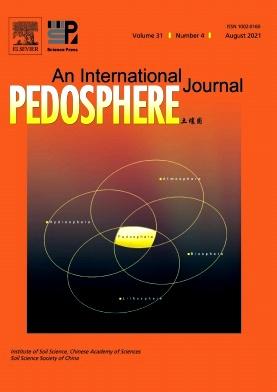Microbial distribution patterns and driving factors related to nitrogen cycling in karst Tiankeng soil
IF 7.3
2区 农林科学
Q1 SOIL SCIENCE
引用次数: 0
Abstract
Soil nitrogen (N) cycling is one of the most critical biogeochemical cycles, and N cycling-related microorganisms are the primary driving force behind N cycling in natural environments. The large karst sinkholes in China, known as Tiankengs, harbor abundant unique biological resources due to their particular environmental conditions. However, N cycling-related microorganisms in Tiankeng soils and their connection to ecosystem processes remain poorly studied. In this study, we investigated the distribution patterns and genomic diversity of N cycling-related microorganisms both inside and outside the Luohun cave Tiankeng in Guizhou, China, utilizing high-throughput sequencing and other techniques. The results indicated that the diversities and abundances of denitrifying bacteria, ammonia-oxidizing bacteria, and ammonia-oxidizing archaea communities inside the Tiankeng were higher than those outside the Tiankeng; however, the microbial network relationships were more fragile inside the Tiankeng. The most abundant species of denitrifying bacteria, ammonia-oxidizing bacteria, and ammonia-oxidizing archaea inside the Tiankeng were unclassified_p_Proteobacteria (47.8%), unclassified_k_norank (AOB, OTU121, 37.3%), and unclassified_g_norank_f_norank_o_norank_c_environmental_samples (55.7%), respectively; outside the Tiankeng, they were unclassified_k_norank_d_bacteria (54.5%), unclassified_k_norank (AOB, OTU121, 48.1%), and unclassified_k_norank (AOA, OTU70, 49.6%), respectively. Additionally, the N content inside the Tiankeng was significantly lower (P < 0.05) under the influence of these N cycling-related microorganisms, whereas the nutrient contents were higher than that outside the Tiankeng. To the best of our knowledge, this is the first report on the crucial microbial distribution patterns driving N cycling in karst Tiankengs and provides new insights into the structure and potential functions of N cycling-related microorganisms in the unique ecological environment of fragile Tiankeng ecosystems.
岩溶天坑土壤中微生物分布模式及氮循环相关驱动因素
土壤氮循环是最重要的生物地球化学循环之一,与氮循环相关的微生物是自然环境中氮循环的主要驱动力。中国大型岩溶天坑因其特殊的环境条件,蕴藏着丰富的独特生物资源。然而,对天坑土壤中与氮循环相关的微生物及其与生态系统过程的关系的研究还很少。本研究利用高通量测序等技术,对贵州罗浑洞天坑内外氮循环相关微生物的分布格局和基因组多样性进行了研究。结果表明:反硝化细菌、氨氧化细菌和氨氧化古菌群落的多样性和丰度在天坑内均高于天坑外;而天坑内部的微生物网络关系较为脆弱。天坑反硝化菌、氨氧化菌和氨氧化古菌的丰度分别为unclassified__proteobacteria(47.8%)、unclassified_k_norank (AOB, OTU121, 37.3%)和unclassified_g_norank_f_norank_o_norank_c_environmental_samples (55.7%);在天坑外,unclassified_k_norank_d_bacteria(54.5%)、unclassified_k_norank (AOB, OTU121, 48.1%)、unclassified_k_norank (AOA, OTU70, 49.6%)。此外,天坑内氮含量显著降低(P <;在这些N循环相关微生物的影响下,土壤养分含量高于天坑外。据我们所知,本文首次报道了喀斯特天坑中驱动氮循环的关键微生物分布模式,为研究脆弱的天坑生态系统独特生态环境中与氮循环相关的微生物结构和潜在功能提供了新的视角。
本文章由计算机程序翻译,如有差异,请以英文原文为准。
求助全文
约1分钟内获得全文
求助全文
来源期刊

Pedosphere
环境科学-土壤科学
CiteScore
11.70
自引率
1.80%
发文量
147
审稿时长
5.0 months
期刊介绍:
PEDOSPHERE—a peer-reviewed international journal published bimonthly in English—welcomes submissions from scientists around the world under a broad scope of topics relevant to timely, high quality original research findings, especially up-to-date achievements and advances in the entire field of soil science studies dealing with environmental science, ecology, agriculture, bioscience, geoscience, forestry, etc. It publishes mainly original research articles as well as some reviews, mini reviews, short communications and special issues.
 求助内容:
求助内容: 应助结果提醒方式:
应助结果提醒方式:


